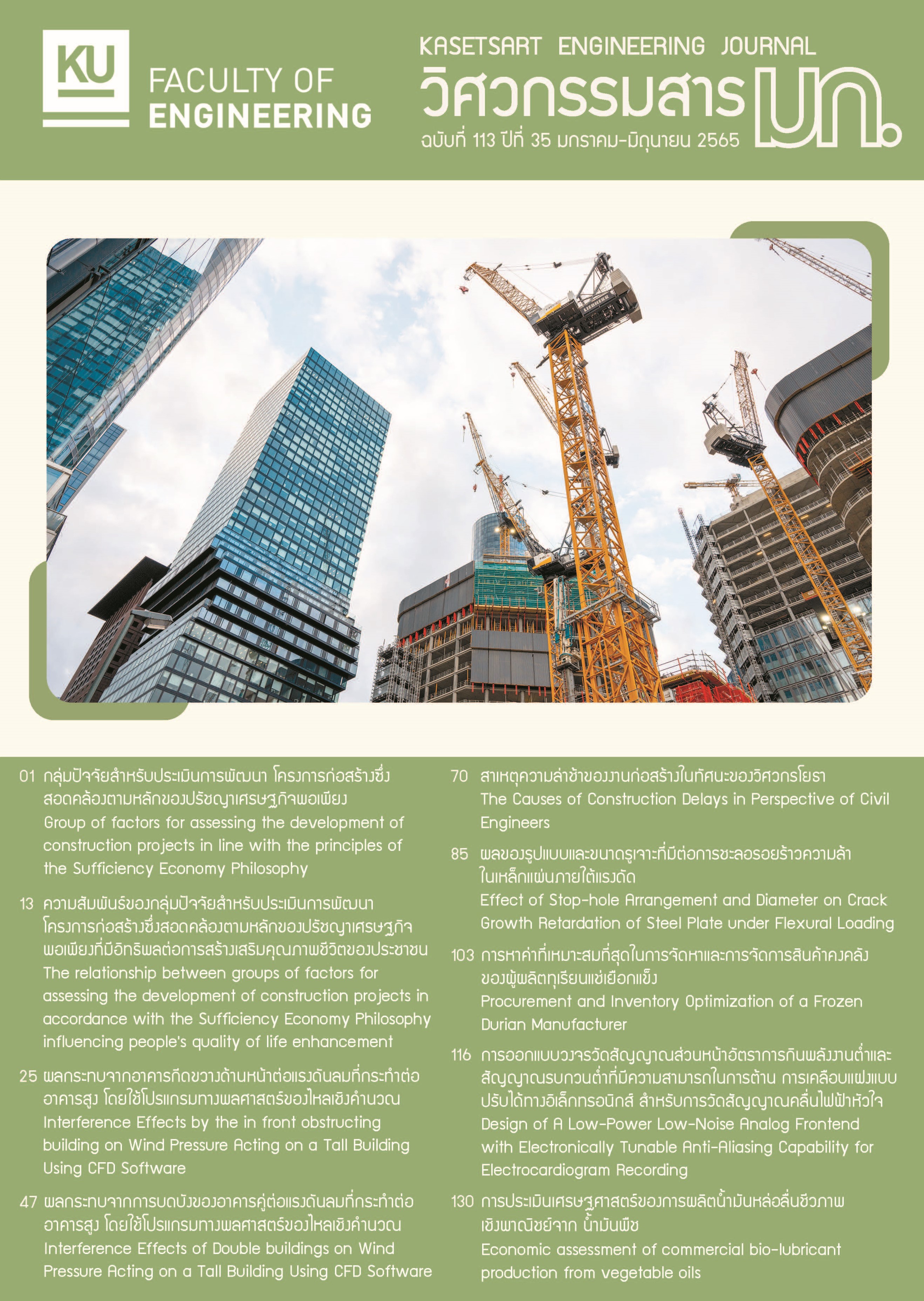ผลของรูปแบบและขนาดรูเจาะที่มีต่อการชะลอรอยร้าวความล้าในเหล็กแผ่นภายใต้แรงดัด
คำสำคัญ:
การชะลอการขยายตัวของรอยร้าว, รอยร้าวความล้า, ไฟไนต์เอลิเมนต์, รูเจาะ, ตำแหน่งรูเจาะบทคัดย่อ
บทความนี้นำเสนอผลรูปแบบและขนาดเส้นผ่านศูนย์กลางของรูเจาะแบบเดี่ยว รูเจาะแบบคู่ และรูเจาะแบบขนาบข้างที่มีต่อการยืดอายุความล้าของแผ่นเหล็กภายใต้แรงดัดนอกระนาบ ผลของรูปแบบการเจาะรูที่มีต่อการชะลอการขยายตัวของรอยร้าวความล้าได้รับการทดสอบในตัวอย่างแผ่นเหล็กจำนวนหกตัวอย่าง ที่มีรอยร้าวทะลุความหนากลางแผ่นเหล็กภายใต้อัตราส่วนความเค้น -1 แบบจำลองไฟไนต์เอลิเมนต์ได้รับการพัฒนาเพื่อประเมินตัวประกอบความเข้มของความเค้นที่ปลายรอยร้าว และความเค้นหนาแน่นรอบรูเจาะ ผลการทดลอง และการวิเคราะห์แสดงให้เห็นว่า การเจาะรูสามารถชะลอการขยายตัวของรอยร้าวภายใต้แรงดัดได้อย่างมีประสิทธิภาพ แบบจำลองไฟไนต์เอลิเมนต์ที่พิจารณาการสัมผัสของผิวรอยร้าวให้ตัวประกอบความเข้มของความเค้น และทิศทางการขยายตัวของรอยร้าวได้อย่างเหมาะสม ความเค้นหนาแน่นรอบรูเจาะลดลงตามการเพิ่มขึ้นของขนาดเส้นผ่านศูนย์กลางรูเจาะ สำหรับขนาดรูเจาะที่เท่ากันรูเจาะแบบขนาบข้างให้ความเค้นหนาแน่นรอบรูเจาะต่ำสุด และมีอายุความล้าของรอยร้าวออกจากรูเจาะมากกว่ารูเจาะแบบคู่และแบบเดี่ยว ตามลำดับ ตำแหน่งรูเจาะแบบขนาบข้างที่มีระยะระหว่างปลายรอยร้าวและจุดศูนย์กลางรูเจาะ เท่ากับ -0.25 เท่าของขนาดเส้นผ่านศูนย์กลางรูเจาะสามารถชะลอการขยายตัวของรอยร้าวได้สูงสุด
References
R J Dexter and J M Ocel (2013). Manual for repair and retrofit of fatigue cracks in steel bridges. Federal Highway Administration, FHWA-IF-13-020.
L Fang, Z Fu, B Ji, and Q Wang (2023). Interference of cracking and drilling on opposite side of steel deck components. Journal of Constructional Steel Research, 208: 107996.
FHWA (2013). Manual for Repair and Retrofit of Fatigue Cracks in Steel Bridges.
FHWA (2012). Manual for Design, Construction and Maintenance of orthotropic steel deck bridges.
H Wu, A Imad, N Benseddiq, J T P D Castro, and M A Meggiolaro (2010). On the prediction of the residual fatigue life of cracked structures repaired by the stop-hole method. International Journal of Fatigue, 32: 670-677.
C S Shin, C M Wang, and P S Song (1996). Fatigue damage repair: a comparison of some possible methods. International Journal of Fatigue, 18: 535-546.
M S Ferdous, C Makabe, M S Rana, and T Miyazaki (2011). Improving the fatigue strength of a multiple hole specimen by applying additional holes or notches, Engineering Failure Analysis, 18: 75-87.
S M J Razavi, M R Ayatollahi, and F Berto (2018). Assessment of fatigue crack growth behavior of cracked specimens repaired by indentation. Procedia Structural Integrity, 13: 69-73.
Y Hu, M Song, J Liu, and M Lei (2020). Effects of stop hole on crack turning, residual fatigue life and crack tip stress field. Journal of the Brazilian Society of Mechanical Sciences and Engineering, 42: 216.
P S Song, Y L Shieh (2004). Stop drilling procedure for fatigue life improvement. International Journal of Fatigue, 26: 1333-1339.
M R Ayatollahi, S M J Razavi, and M Y Yahya (2015). Mixed mode fatigue crack initiation and growth in a CT specimen repaired by stop hole technique. Engineering Fracture Mechanics, 145: 115-127.
S M J Razavi, M R Ayatollahi, C Sommitsch, and C Moser (2017). Retardation of fatigue crack growth in high strength steel S690 using modified stop-hole technique, Engineering Fracture Mechanics, 169: 226-237.
M R Ayatollahi, S M J Razavi, and H R Chamani (2014). A numerical study on the effect of symmetric crack flank holes on fatigue life extension of a SENT specimen. Fatigue and Fracture of Engineering Materials and Structures, 37: 1153-1164.
M Li, Y Suzuki, K Hashimoto, K Sugiura (2018). Experimental study on fatigue resistance of rib-to-deck joint in orthotropic steel bridge deck. Journal of Bridge Engineering, 23(2): 04017128.
มาตรฐานผลิตภัณฑ์อุตสาหกรรม (มอก. 1479-2558) (2558).เหล็กกล้าทรงแบนรีดร้อนสำหรับงานโครงสร้างทั่วไป, สำนักงานมาตรฐานผลิตภัณฑ์อุตสาหกรรม, กระทรวงอุตสาหกรรม.
IIW (2012). Recommendations for fatigue design of welded joints and components.
M Li, K Hashimoto, and K Sugiura (2014). Influence of Asphalt Surfacing on Fatigue Evaluation of Rib-to-Deck Joints in Orthotropic Steel Bridge Decks. Journal of Bridge Engineering, 04014038.
G M Sayeed Ahmed, A Algahtani, E R I Mahmoud, and I A Badruddin (2018). Experimental evaluation of interfacial surface cracks in friction welded dissimilar metals through image segmentation technique (IST). International Journal of Materials, 11: 2460.
P Albrecht, and A Lenwari (2006). Stress intensity factor for center-cracked plate with crack surface interference. Engineering Fracture Mechanics, 73: 1035-1045.
Y Lei (2008). Finite element crack closure analysis of a compact tension specimen. International Journal of Fatigue, 30: 21–31.
NASGRO (2010). Fracture mechanics and fatigue crack growth analysis software (version 6.0), reference manual, NASA Johnson Space Center and Southwest Research Institute.
H A Richard, B Schramm, and N H Schirmeisen (2014). Cracks on Mixed Mode loading-Theories, experiments, simulations. International Journal of Fatigue, 62: 93-103.
Downloads
เผยแพร่แล้ว
ฉบับ
บท
License

This work is licensed under a Creative Commons Attribution-NonCommercial-NoDerivatives 4.0 International License.

